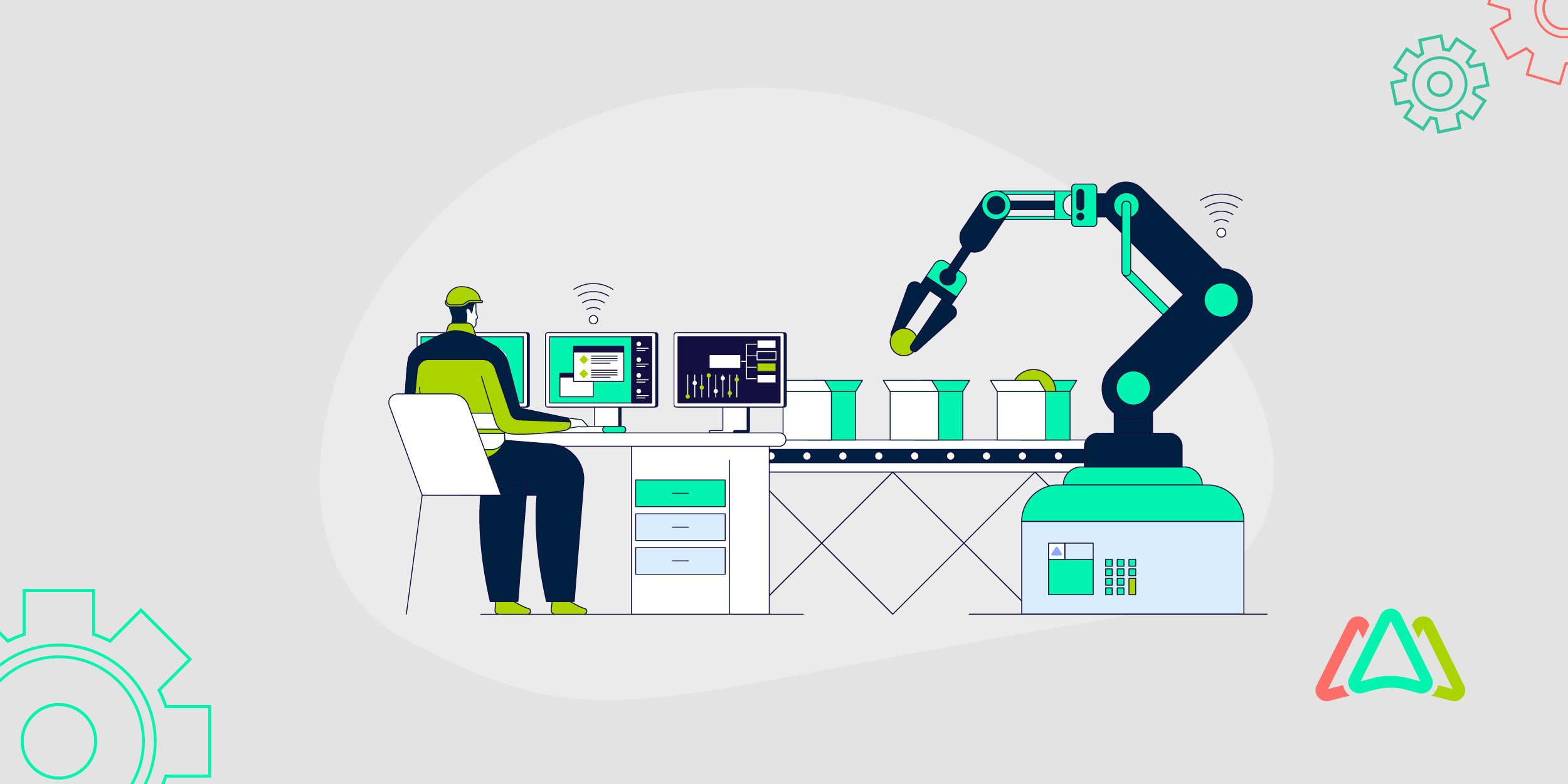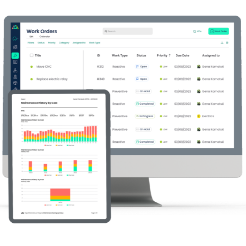
The Role of Edge Computing in Real-Time Preventive Maintenance
Edge computing is an innovative technology that enables data to be processed at the source, facilitating immediate decision-making without relying heavily on cloud services. It is estimated that 90% of industrial enterprises will employ edge computing. Frost & Sullivan predicted that this would happen before 2022. This highlights how remarkable the adoption will be in upcoming years. Edge computing is revolutionizing maintenance, making real-time preventive maintenance faster, smarter, and more cost-effective than ever before.
Traditionally, preventive maintenance was time-based, machines were serviced at scheduled intervals, whether they needed it or not. This decreased the chance of breaking down, but it involved unnecessary service, led to higher costs, and caused more failures at times between those regular inspections.
Real-time preventive maintenance depends on large volumes of data, which traditional cloud computing struggles to handle. Sending sensor data to the cloud for processing creates latency, and when milliseconds matter, delays can be disastrous. This article explores what edge computing is, how it differs from cloud computing, and the role it plays in real-time preventive maintenance.
Understanding Real-Time Preventive Maintenance
Real-time preventive maintenance relies on the immediate processing of data to identify failures before they happen. Traditional preventive maintenance involves triggering maintenance tasks according to a strict schedule, while real-time preventive maintenance monitors equipment in real-time, allowing maintenance to be performed only when absolutely necessary and avoiding unnecessary downtime and expense.
Real-time preventive maintenance is also different from predictive maintenance that relies on historical data and machine learning models. Predictive maintenance identifies failures percentage based on trends, whereas real-time preventive maintenance responds instantaneously to live sensor data, trapping issues before they become issues.
In industries such as manufacturing, energy, and healthcare, seconds can make a significant difference, so instant data processing is essential. Small delays in detecting when a turbine is overheating, or recognizing when pressure drops in a faulty pipeline, can result in catastrophic failures. Intervening immediately with real-time preventive maintenance enables companies to be more efficient, ensure the longevity of their assets, and reduce costly interruptions.
What is Edge Computing?
Edge computing is a technology that processes data at the device or machine level, close to the source, and not on distant cloud servers. It facilitates quick decision-making with very little lag. Unlike cloud computing, which requires sending data to centralized servers for processing, edge computing analyzes information locally, thereby minimizing delays and reducing bandwidth costs.
This is revolutionary in industrial maintenance. Since real-time preventive maintenance relies on an immediate response, edge computing enables the instant identification of critical equipment problems, thereby minimizing costly breakdowns and downtime. It also improves speed, reliability, and security, enabling smarter and more efficient maintenance.
How Edge Computing Enhances Real-Time Preventive Maintenance
Edge computing eliminates delays, enhances reliability, and facilitates faster decision-making by moving data processing closer to the source. This change is particularly significant for industries that rely on real-time monitoring to prevent equipment failures and optimize their performance. The following are five ways edge computing facilitates real-time preventive maintenance:
1. Faster Data Processing: Eliminating Cloud Latency
In traditional cloud-based maintenance systems, data must be sent to remote servers for analysis. Even if this only takes a few seconds, in an industrial setting, it can be a costly delay. Edge computing processes locally, reducing latency and enabling near-immediate insight into equipment performance. This matters in industries where split-second decisions avert breakdowns.
2. Reduced Downtime: Instant Fault Detection and Response
A slight change in vibration from a factory motor may signal an impending failure. As with edge computing, sensors can identify abnormal behavior in real-time and automatically alert or take corrective measures to prevent failure. This proactive approach reduces unplanned downtime, which can cost manufacturers as much as $260,000 per hour.
3. Enhanced Reliability: On-Site Decision-Making Without Cloud Dependence
Cloud outages or network disruptions can leave maintenance teams blind to critical issues. Edge computing ensures continuous monitoring, even if cloud services go down.
4. Lower Bandwidth Costs: Processing Data Locally
Sending huge quantities of sensor data to the cloud can be costly. Edge computing curates and processes data at the source, sending only the most relevant insights to the cloud. It further lowers bandwidth costs, making real-time preventive maintenance feasible as opposed to expensive.
5. Cybersecurity Advantages: Minimizing Risks from Cloud Exposure
Because industrial control systems are vulnerable to cyberattacks, data security remains a major challenge. Edge computing allows the sensitive maintenance data to remain close to the source, minimizing the attack surface to potential cloud-based threats. Previous cyber incidents exposed weaknesses in the organization’s infrastructure, making it vital to strengthen cyber resilience by minimizing external data transfers and protecting data on systems.
Edge Computing vs. Cloud Computing in Preventive Maintenance
Both edge computing and cloud computing play crucial roles in maintenance strategies, but they serve different purposes. Edge computing excels in real-time decision-making, while cloud computing is better suited for large-scale data storage and analysis. The table below highlights the key differences to help industries choose the right approach based on their needs.
|
Factor |
Edge Computing |
Cloud Computing |
|
Speed |
Ultra-fast processes data locally with near-zero latency. |
Slower due to data transmission delays to remote servers. |
|
Cost |
Edge computing has lower bandwidth costs but higher initial infrastructure investment. |
Cloud computing has lower upfront costs but higher ongoing expenses for bandwidth and processing. |
|
Security |
It is more secure because data is processed on-site, reducing cloud exposure. |
It is prone to higher risk due to vulnerabilities in data transmission and cloud-based systems. |
|
Reliability |
Works even if the internet or cloud services go down, ensuring continuous monitoring. |
Dependent on internet connectivity and cloud uptime, prone to outages. |
|
Scalability |
Limited by hardware capacity and deployment costs. |
Highly scalable, supports large-scale data storage and processing. |
|
Use Case |
Edge computing is Ideal for real-time preventive maintenance in manufacturing, oil & gas, healthcare, and critical infrastructure, where immediate action is needed. |
Cloud computing is best suitable for long-term data storage, machine learning analysis, and predictive maintenanc,e where immediate responses aren’t required. |
Challenges and Considerations in Implementing Edge Computing for Maintenance
While edge computing offers significant benefits for real-time preventive maintenance, organizations must weigh the associated technical, financial, and security challenges. Careful consideration of these aspects is crucial for efficient and effective implementation.
Infrastructure Costs and Deployment Challenges
Edge computing demands significant upfront capital investment in hardware, encompassing IoT sensors, edge servers, and networking infrastructure. Unlike cloud solutions that leverage shared resources, edge computing necessitates onsite installations. This results in greater initial expenditure and increased IT and maintenance resource allocation.
Data Integration Issues with Existing CMMS/ERP Systems
Companies often depend on CMMS and ERP software for asset tracking and maintenance scheduling. Real-time integration with edge data can pose a challenge, frequently necessitating the development of APIs, middleware, or software upgrades to bridge legacy systems.
Scalability and Interoperability Concerns
Edge computing solutions must be scalable to accommodate expanding operations and new assets. However, ensuring compatibility across different vendors, devices, and protocols is a major challenge. Standardization efforts are improving, but organizations must carefully evaluate interoperability when adopting edge solutions.
Security Risks and Compliance
Although cloud-based threats are reduced with edge computing, new security challenges arise. Since multiple decentralized devices will be working with data, organizations need to put strong encryption, strict access controls, and frequent firmware updates in place. Moreover, industries with stringent regulatory compliance (like healthcare, finance, or energy) need to make sure that edge deployments follow regulatory standards, such as ISO 27001 or GDPR.
Future Trends: The Evolution of Edge Computing in Maintenance
Real-time preventive maintenance systems are poised for significant advancements due to the integration of 5G connectivity. This technology enables ultra-sharp data transmission, facilitating instantaneous communication between sensors, machines, and maintenance teams. Furthermore, the future of edge computing in maintenance points towards localized data processing and autonomous self-management. AI-powered autonomous systems will not only report incidents but also rectify minor faults without requiring human intervention.
Additionally, the convergence of IoT, AI, and edge computing in Industry 4.0 will create fully interconnected smart factories, where predictive analytics, automation, and decentralized decision-making work together to eliminate unplanned downtime, optimize maintenance efficiency, and extend asset lifespan like never before.
Conclusion: Staying Ahead
Edge computing is transforming real-time preventive maintenance by enabling immediate data analysis, faster fault detection, and proactive decision-making directly at the machine level. This approach overcomes the latency and connectivity challenges often associated with cloud-based solutions, allowing for continuous monitoring and real-time responses that minimize downtime and improve asset reliability.
Industries such as manufacturing, healthcare, and energy, which depend on uninterrupted operations, must adopt edge technology to stay competitive, reduce operational risks, and lower maintenance costs. As AI, IoT, and 5G technologies advance, edge computing will be crucial in developing intelligent, self-sustaining maintenance ecosystems. In these systems, machines will be able to detect, analyze, and even self-correct failures without human intervention. By investing in this transition now, organizations can future-proof their maintenance strategies, ensuring optimal efficiency, cost savings, and sustained asset performance.
TABLE OF CONTENTS
Keep Reading
Selecting a Computerized Maintenance Management System (CMMS) can, at first glance, be an ...
4 Nov 2025
In healthcare facilities, equipment uptime involves more than achieving operational ...
31 Oct 2025
Companies are subject to economic ups and downs, also known as economic volatility. Today, ...
30 Oct 2025
Maintenance challenges are a constant struggle, with unplanned downtime costing manufacturers ...
27 Oct 2025
Last winter, a maintenance technician at a U.S. paper mill ignored a predictive alert that ...
10 Oct 2025
Many organizations proudly say they “have a CMMS,” but ownership alone doesn’t equal ...
9 Oct 2025
Every maintenance team is under pressure to do more with less. Unplanned downtime is often ...
7 Oct 2025
The implementation of simple, yet powerfully effective, checklists has repeatedly ...
3 Oct 2025
In manufacturing, every second counts. When production stops, whether due to scheduled ...
2 Oct 2025
The increasing cost of maintenance, lack of accountability, and siloed systems leave many ...
30 Sep 2025
Preventive maintenance is one of those things maintenance teams know they need to do, but it ...
26 Sep 2025
Public services are essential to daily life. The provision of safe roads, functional transit, ...
25 Sep 2025
For most manufacturing facilities, a major focus of their maintenance teams revolves around ...
24 Sep 2025
Have you ever tried explaining to the CEO why the production line has been down for hours ...
18 Sep 2025
Over the past few decades, the hotel industry has undergone a dramatic transformation. ...
16 Sep 2025
Profitability is at the top of the list for manufacturing organizations when conversations ...
12 Sep 2025
Lean manufacturing is a goal that organizations strive for in their quest for operational ...
11 Sep 2025
In many organizations, the primary focus of maintenance work is on completing work orders, ...
9 Sep 2025
Word order backlogs are a reality that all maintenance and facilities management teams face. ...
5 Sep 2025
The critical nature of medical equipment has made maintenance management in healthcare ...
4 Sep 2025







